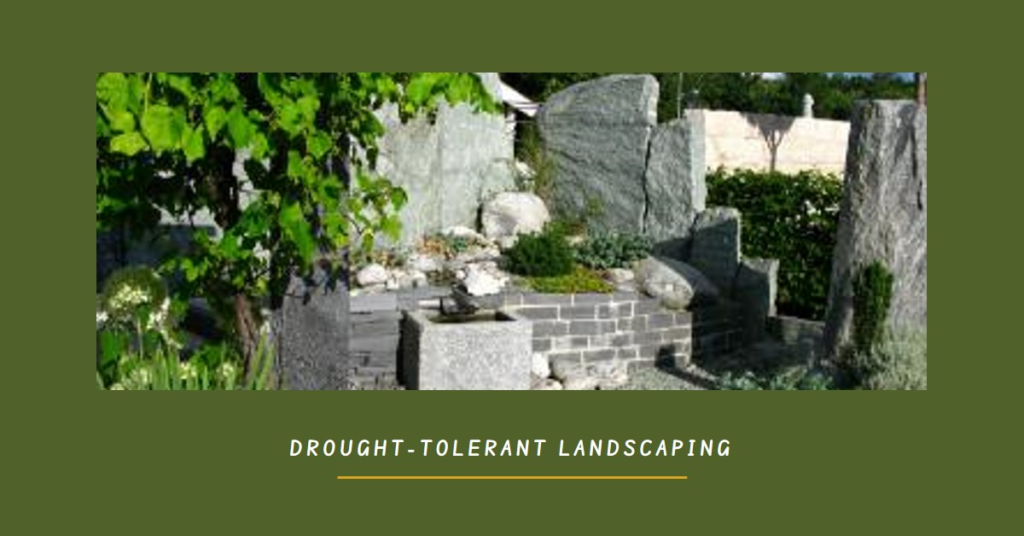
Table of Contents
- Introduction to Landscape
- Embracing Xeriscaping: The Art of Water-Wise Gardening
- Selecting the Right Plants: A Palette for Drought-Resistance
- Efficient Irrigation Systems: Maximizing Every Drop
- Soil Preparation: Building a Foundation for Resilience
- Hardscaping Elements: Enhancing Beauty and Functionality
- Creating Shade: Natural Cooling Solutions
- Water Harvesting: Capturing and Reusing Rainwater
- Low-Maintenance Lawns: Alternatives to Traditional Turf
- Wildlife-Friendly Gardens: Supporting Local Ecosystems
- Conclusion: Cultivating Sustainable Beauty
Introduction to Landscape
In a world where water conservation is becoming increasingly vital, homeowners and landscapers are turning to drought-tolerant landscaping options. These choices not only save water but also create stunning, sustainable outdoor spaces. This blog post delves into various aspects of drought-tolerant landscaping, offering practical advice and inspiration for creating a lush, low-water garden.
Embracing Xeriscaping: The Art of Water-Wise Gardening
Xeriscaping, derived from the Greek word “xeros” meaning dry, is a landscaping method that reduces or eliminates the need for irrigation. This approach involves selecting plants that thrive in arid conditions and designing landscapes that utilize water efficiently.
One of the fundamental principles of xeriscaping is the strategic use of native plants. Native species are naturally adapted to the local climate and soil conditions, requiring minimal water and maintenance. Additionally, grouping plants with similar water needs together can further reduce water usage, creating a cohesive and sustainable landscape.
Selecting the Right Plants: A Palette for Drought-Resistance
Choosing the right plants is crucial for a successful drought-tolerant garden. Succulents, for example, are a popular choice due to their ability to store water in their leaves, stems, and roots. Varieties such as agave, aloe, and sedum offer unique textures and shapes, adding visual interest to any garden.
Grasses like blue fescue and ornamental grasses provide movement and texture, while drought-tolerant shrubs such as lavender, rosemary, and sage offer fragrance and color. Perennials like echinacea and black-eyed Susan bloom beautifully with minimal water, attracting pollinators and adding vibrant hues to the landscape.
Efficient Irrigation Systems: Maximizing Every Drop
Even drought-tolerant plants need water, especially during their establishment period. Efficient irrigation systems are essential for maximizing water use and ensuring plant health. Drip irrigation is a highly effective method, delivering water directly to the plant roots and reducing evaporation.
Incorporating moisture sensors and smart controllers into your irrigation system can further enhance water efficiency. These technologies adjust watering schedules based on soil moisture levels and weather conditions, ensuring that plants receive the right amount of water without waste.
Soil Preparation: Building a Foundation for Resilience
Healthy soil is the cornerstone of a successful drought-tolerant garden. Well-prepared soil retains moisture better, supports plant health, and reduces the need for frequent watering. Start by testing your soil to determine its composition and nutrient levels. Amending the soil with organic matter, such as compost, can improve its structure, water retention, and fertility.
Mulching is another crucial practice in drought-tolerant landscaping. A thick layer of mulch around plants helps retain soil moisture, suppress weeds, and regulate soil temperature. Organic mulches like wood chips, straw, or bark break down over time, enriching the soil and promoting a healthy ecosystem.
Hardscaping Elements: Enhancing Beauty and Functionality
Incorporating hardscaping elements into your landscape design can significantly reduce water use while adding beauty and functionality. Features such as patios, walkways, and rock gardens create visually appealing spaces that require no watering.
Consider using permeable materials for hardscaping to allow rainwater to infiltrate the soil, reducing runoff and promoting groundwater recharge. Gravel, decomposed granite, and permeable pavers are excellent choices for creating paths and patios that blend seamlessly with the natural surroundings.


Creating Shade: Natural Cooling Solutions
Shade plays a vital role in reducing water evaporation and maintaining a cooler microclimate in your garden. Planting trees and large shrubs strategically can provide much-needed shade for smaller plants, reducing their water needs.
Deciduous trees, which shed their leaves in winter, are particularly beneficial as they provide shade during the hot summer months and allow sunlight to reach plants in the cooler seasons. Additionally, installing shade structures like pergolas or shade sails can protect sensitive plants and create comfortable outdoor living areas.
Water Harvesting: Capturing and Reusing Rainwater
Rainwater harvesting is an excellent strategy for reducing reliance on municipal water supplies. Installing rain barrels or larger cisterns can capture and store rainwater from your roof, providing a free and sustainable water source for your garden.
Using collected rainwater for irrigation is both environmentally friendly and cost-effective. Moreover, it reduces the strain on local water resources, especially during periods of drought. Ensure that your rainwater harvesting system includes filters to keep debris out and prevent mosquito breeding.
Low-Maintenance Lawns: Alternatives to Traditional Turf
Traditional lawns are often the biggest water guzzlers in residential landscapes. Fortunately, there are many low-maintenance alternatives that offer the look of a lush lawn without the water demand. Groundcovers such as creeping thyme, clover, and buffalo grass are excellent substitutes for traditional turf, providing green coverage and requiring minimal irrigation.
Artificial turf is another option for areas where a green lawn is desired without the upkeep and water usage. Modern artificial grasses look realistic and offer a durable, pet-friendly surface that requires no watering or mowing.
Wildlife-Friendly Gardens: Supporting Local Ecosystems
A well-designed drought-tolerant garden can support local wildlife by providing food, shelter, and water sources. Native plants, in particular, attract pollinators such as bees, butterflies, and hummingbirds, promoting biodiversity and a healthy ecosystem.
Incorporating features like bird baths, nesting boxes, and insect hotels can enhance your garden’s appeal to wildlife. Additionally, creating a variety of plant heights and densities offers habitats for different species, from ground-dwelling insects to perching birds.
Conclusion: Cultivating Sustainable Beauty
Creating a drought-tolerant landscape does not mean sacrificing beauty or functionality. By carefully selecting plants, implementing efficient irrigation systems, and incorporating hardscaping and shade elements, you can design a garden that thrives with minimal water. Embrace the principles of xeriscaping and sustainable gardening to cultivate a landscape that is not only resilient to drought but also a haven for local wildlife and a source of enduring beauty.
Transitioning to drought-tolerant landscaping is a responsible and rewarding choice, ensuring that your garden remains vibrant and sustainable in the face of water scarcity. With thoughtful planning and execution, you can enjoy a lush, water-wise landscape that stands the test of time.


